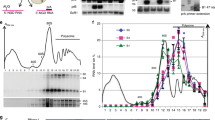Abstract
In eukaryotes, the maturation of the 3′ ends of most transcripts involves cleavage and polyadenylation steps in the nucleus. While I was working in the group of Katherine Borden at the University of Montréal, we reported that the eukaryotic translation initiation factor 4E (eIF4E) promotes the 3′ end cleavage of specific RNAs. Here, I describe how we monitored this specific maturation pathway using subcellular fractionation, quantitative RT-PCR, and an in vitro cleavage assay with the nuclear fraction.
Access this chapter
Tax calculation will be finalised at checkout
Purchases are for personal use only
Similar content being viewed by others
References
Culjkovic B, Topisirovic I, Skrabanek L et al (2006) eIF4E is a central node of an RNA regulon that governs cellular proliferation. J Cell Biol 175:415–426
Rosenwald IB, Kaspar R, Rousseau D et al (1995) Eukaryotic translation initiation factor 4E regulates expression of cyclin D1 at transcriptional and post-transcriptional levels. J Biol Chem 270:21176–21180
Ferraiuolo MA, Basak S, Dostie J et al (2005) A role for the eIF4E-binding protein 4E-T in P-body formation and mRNA decay. J Cell Biol 170:913–924
Borden KL (2016) The eukaryotic translation initiation factor eIF4E wears a “cap” for many occasions. Translation (Austin) 4:e1220899
Culjkovic B, Topisirovic I, Skrabanek L et al (2005) eIF4E promotes nuclear export of cyclin D1 mRNAs via an element in the 3′UTR. J Cell Biol 169:245–256
Culjkovic-Kraljacic B, Baguet A, Volpon L et al (2012) The oncogene eIF4E reprograms the nuclear pore complex to promote mRNA export and oncogenic transformation. Cell Rep 2:207–215
Topisirovic I, Siddiqui N, Lapointe VL et al (2009) Molecular dissection of the eukaryotic initiation factor 4E (eIF4E) export-competent RNP. EMBO J 28:1087–1098
Culjkovic-Kraljacic B, Fernando TM, Marullo R et al (2016) Combinatorial targeting of nuclear export and translation of RNA inhibits aggressive B-cell lymphomas. Blood 127:858–868
Fuke H, Ohno M (2008) Role of poly (A) tail as an identity element for mRNA nuclear export. Nucleic Acids Res 36:1037–1049
Davis MR, Delaleau M, Borden KLB (2019) Nuclear eIF4E stimulates 3′-end cleavage of target RNAs. Cell Rep 27:1397–1408. e1394
Goodwin EC, Rottman FM (1992) The 3′-flanking sequence of the bovine growth hormone gene contains novel elements required for efficient and accurate polyadenylation. J Biol Chem 267:16330–16334
Kolev NG, Steitz JA (2005) Symplekin and multiple other polyadenylation factors participate in 3′-end maturation of histone mRNAs. Genes Dev 19:2583–2592
Lai HK, Borden KL (2000) The promyelocytic leukemia (PML) protein suppresses cyclin D1 protein production by altering the nuclear cytoplasmic distribution of cyclin D1 mRNA. Oncogene 19:1623–1634
Acknowledgments
I gratefully acknowledge Pr. Katherine Borden for the opportunity to perform this work in her laboratory at University of Montréal (Canada) as well as Dr. Marc Boudvillain for critical reading and editing of this manuscript.
Author information
Authors and Affiliations
Corresponding author
Editor information
Editors and Affiliations
Rights and permissions
Copyright information
© 2021 Springer Science+Business Media, LLC, part of Springer Nature
About this protocol
Cite this protocol
Delaleau, M. (2021). Monitoring eIF4E-Dependent Nuclear 3′ End mRNA Cleavage. In: Boudvillain, M. (eds) RNA Remodeling Proteins. Methods in Molecular Biology, vol 2209. Humana, New York, NY. https://doi.org/10.1007/978-1-0716-0935-4_22
Download citation
DOI: https://doi.org/10.1007/978-1-0716-0935-4_22
Published:
Publisher Name: Humana, New York, NY
Print ISBN: 978-1-0716-0934-7
Online ISBN: 978-1-0716-0935-4
eBook Packages: Springer Protocols




